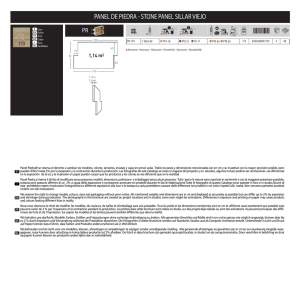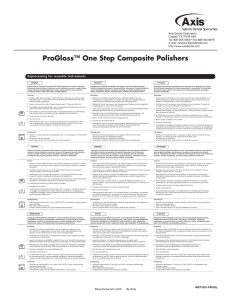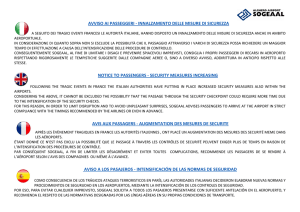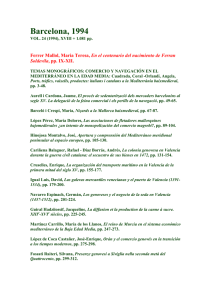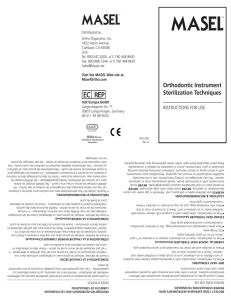Instructions For Use: Tango-Endo™ Instruments Instructions For Use
Anuncio
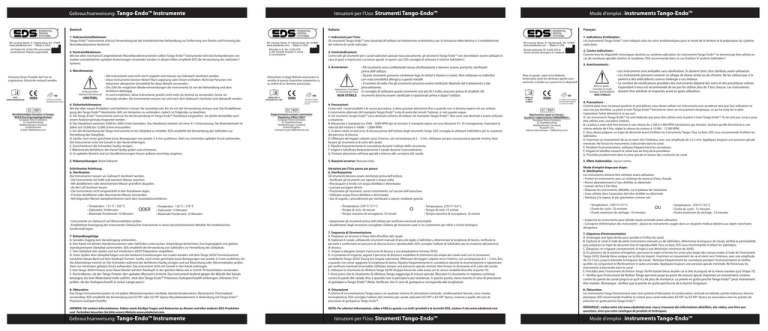
Gebrauchsanweisung: Tango-Endo™ Instrumente ESSENTIAL DENTAL SYSTEMS 89 Leuning Street, S. Hackensack, NJ 07606 www.edsdental.com • Made in USA US-Patent Nr. 6.042.376 und andere ausländische Patente angemeldet. Istruzioni per l’Uso: Strumenti Tango-Endo™ Deutsch 1. Gebrauchsindikationen: Tango-Endo™ Instrumente sind zur Verwendung bei der endodontischen Behandlung zur Entfernung von Dentin und Formung des Wurzelkanalsystems bestimmt. 2. Kontraindikationen: Wie bei allen mechanisch angetriebenen Wurzelkanalinstrumenten sollten Tango-Endo™ Instrumente nicht bei Vorhandensein von starken und plötzlichen apikalen Krümmungen verwendet werden. In diesen Fällen empfiehlt EDS die Verwendung des SafeSiders® Systems. ESSENTIAL DENTAL SYSTEMS 89 Leuning Street, S. Hackensack, NJ 07606 www.edsdental.com • Made in USA Brevetto U.S. No. 6.042.376 e altri brevetti stranieri in corso di concessione. SIEHE GEBRAUCHSANWEISUNG 0086 Achtung! Siehe Gebrauchsanweisung! UMTAUSCH NUR MIT UNVERSEHRTEM SIEGEL EC REP Bevollmächtigter Vertreter in Europa: NUR Zulassungsangelegenheiten: European Device Solutions 33, Stapleford Road, Middlesbrough, Cleveland, Großbritannien E-Mail: [email protected] UNSTERIL • Die Instrumente sind nicht steril verpackt und müssen vor Gebrauch sterilisiert werden. • Diese Instrumente können Nickel-Titan-Legierung oder Chrom enthalten. Nicht bei Personen mit bekannter allergischer Sensibilität für diese Metalle verwenden. • Die Zahl der möglichen Wiederverwendungen der Instrumente ist von der Behandlung und dem Verfahren abhängig. Es wird empfohlen, diese Instrumente jeweils nicht mehr als dreimal zu verwenden, bevor sie entsorgt werden. Die Instrumente müssen vor und nach dem Gebrauch sterilisiert und überprüft werden. 4. Sicherheitshinweise: Wie bei allen neuen Produkten und Verfahren müssen Sie vorsichtig sein, bis Sie mit der Verwendung vertraut sind. Die Pendelbewegung des Tango-Endo™ Handstücks hilft, ein Verkanten zu verhindern. Jedoch ist Folgendes zu beachten: A. Die Tango-Endo™ Instrumente sind nur für die Verwendung im Tango-Endo™ Handstück vorgesehen. Sie dürfen keinesfalls nach einem Rotationsprinzip eingesetzt werden. B. Das Handstück zwischen 2500 bis 3000 U/min betreiben. Das Handstück arbeitet mit einer 4:1-Untersetzung. Die Motordrehzahl ist daher auf 10.000 bis 12.000 U/min einzustellen. C. Vor der Verwendung der Tango Instrumente ist ein Gleitpfad zu erstellen. EDS empfiehlt die Verwendung der SafeSiders zur Herstellung des Gleitpfads. D. Sanfte, nach innen gerichtete kurze Bewegungen von jeweils 2-3 mm ausführen. Stets nur minimalen apikalen Druck aufwenden. Die Instrumente nicht mit Gewalt in den Kanal einbringen. E. Zwischendurch die Schneiden häufig reinigen. F. Während des Verfahrens den Kanal häufig spülen und schmieren. G. Im apikalen Bereich und um Kanalkrümmungen herum äußerst vorsichtig vorgehen. 5. Nebenwirkungen: Keine bekannt. Schrittweise Anleitung: 6. Sterilisation Die Instrumente müssen vor Gebrauch sterilisiert werden. • Die Instrumente mit Seife und warmem Wasser waschen. • Mit destilliertem oder deionisiertem Wasser gründlich abspülen. • An der Luft trocknen lassen. • Die Instrumente nicht eingewickelt in den Autoklaven legen. • Frisches destilliertes oder deionisiertes Wasser verwenden. • Mit folgenden Werten dampfsterilisieren nach dem Gravitationsverfahren: • Temperatur: 121 °C / 250 °C • Zykluszeit: 20 Minuten • Maximale Trockenzeit: 10 Minuten ODER • Temperatur: 132 °C / 270 °F • Zykluszeit: 15 Minuten • Maximale Trockenzeit: 10 Minuten • Instrumente vor Gebrauch auf Abnormalitäten prüfen. • Empfohlene Entsorgung der Instrumente: Gebrauchte Instrumente in einen durchstichsicheren Behälter für medizinischen Sondermüll legen. 7. Behandlungsfolge A. Geraden Zugang zum Kanaleingang vorbereiten. B. Den Kanal mit kleinen Handinstrumenten oder SafeSiders untersuchen. Arbeitslänge bestimmen, Durchgängigkeit und glatten, reproduzierbaren Gleitpfad sicherstellen. EDS empfiehlt die Verwendung von SafeSiders zur Herstellung des Gleitpfads. C. Den Gleitpfad stets spülen und auf mindestens 20/02 Präparation vergrößern. D. Unter Spülen dem Gleitpfad folgen und die breiteren Erweiterungen von ovalen Kanälen mit dem Tango 30/02 Forminstrument (einzelnes blaues Band auf dem Rastkopf ) formen. Sanfte, nach innen gerichtete kurze Bewegungen von jeweils 2-3 mm ausführen, bis die Arbeitslänge erreicht ist. Die Schneiden während des Verfahrens häufig reinigen und auf Abwicklung oder Abnormalitäten prüfen. Stets nur minimalen apikalen Druck aufwenden. Das Instrument nicht mit Gewalt in den Kanal einbringen. E. Den Tango 30/04 Finierer (zwei blaue Bänder auf dem Rastkopf ) in der gleichen Weise wie in Schritt 7D beschrieben verwenden. F. Kontrollieren, ob der Tango Finierer den apikalen Messwert erreicht. Das Instrument laufend gegen die Wände des Kanals Italiano 1. Indicazioni per l’Uso: Gli strumenti Tango-Endo™ sono destinati all’utilizzo nel trattamento endodontico per la rimozione della dentina e il modellamento del sistema di canali radicolari. 2. Controindicazioni: Come tutti gli strumenti per i canali radicolari azionati meccanicamente, gli strumenti Tango-Endo™ non dovrebbero essere utilizzati in caso di gravi e improvvise curvature apicali. In questi casi, EDS consiglia di utilizzare il sistema SafeSiders®. 3. Avvertenze: 3. Warnhinweise: Achtung: Dieses Produkt darf nur an zugelassene Zahnärzte verkauft werden. Attenzione: Le leggi federali autorizzano la vendita di questo dispositivo solamente a o su ordine di un dentista autorizzato. Attenzione, Consultare le Istruzioni per l’Uso CONSULTARE LE ISTRUZIONI PER L’USO 0086 NON STERILE NON RESTITUIBILE IN CASO DI SIGILLO ROTTO EC REP Rappresentante europeo autorizzato: Regulatory Affairs ONLY: European Device Solutions 33, Stapleford Road, Middlesbrough, Cleveland, United Kingdom. Contatto Email: [email protected] Mode d'emploi : instruments Tango-Endo™ • Gli strumenti sono confezionati senza sterilizzazione e devono essere, pertanto, sterilizzati prima dell’utilizzo. • Questi strumenti possono contenere lega di nichel e titanio o cromo. Non utilizzare su individui con nota sensibilità allergica a questi metalli. • Il numero di volte che gli strumenti possono essere riutilizzati dipende dal trattamento e dal procedimento. Si consiglia di utilizzare questi strumenti non più di 3 volte ciascuno prima di smaltirli. Gli strumenti devono essere sterilizzati e ispezionati prima e dopo l’utilizzo. 4. Precauzioni: Come tutti i nuovi prodotti e le nuove procedure, si deve prestare attenzione fino a quando non si diventa esperti nel suo utilizzo. Il movimento alternato del manipolo Tango-Endo™ evita di avere dei vincoli. Tuttavia, si noti quanto segue: A. Gli strumenti Tanglo-Endo™ sono destinati soltanto all’utilizzo nel manipolo Tanglo-Endo™. Non sono mai destinati a essere utilizzati a rotazione. B. Manovrare il manipolo tra 2500 – 3000 RPM (giri al minuto). Il manipolo opera con una riduzione 4:1. Di conseguenza, impostare la velocità del motore a 10000 – 12000 RPM. C. Si deve creare un percorso di discesa prima dell’utilizzo degli strumenti Tango. EDS consiglia di utilizzare SafeSliders per la creazione del percorso di discesa. D. Effettuare dei leggeri colpetti verso l’interno, con un’ampiezza di 2 – 3 mm. Utilizzare sempre una pressione apicale minima. Non forzare gli strumenti al di sotto del canale. E. Ripulire frequentemente le scanalature durante l’utilizzo dello strumento. F. Irrigare e lubrificare frequentemente il canale durante il procedimento. G. Prestare attenzione nell’area apicale e attorno alle curvature del canale. ESSENTIAL DENTAL SYSTEMS 89 Leuning Street, S. Hackensack, NJ 07606 www.edsdental.com • Made in USA Brevet américain N° 6,042,376 et autres brevets étrangers en instance. Français 1. Indications d'utilisation : Les instruments Tango-Endo™ sont indiqués dans les soins endodontiques pour le retrait de la dentine et la préparation du système radiculaire. 2. Contre-indications : Comme tous les dispositifs mécaniques destinés au système radiculaire, les instruments Tango-Endo™ ne doivent pas être utilisés en cas de courbures apicales sévères et soudaines. EDS recommande dans ce cas d'utiliser le système SafeSiders®. 3. Avertissements : Mise en garde : selon la loi fédérale américaine, seuls les dentistes agréés sont autorisés à vendre ou à prescrire ce dispositif. CONSULTEZ LE MODE D'EMPLOI 0086 Mise en garde : Consultez le mode d'emploi. INSTRUMENTS NON STÉRILES LE PRODUIT NE POURRA PAS ÊTRE RETOURNÉ SI LE SCEAU EST BRISÉ. EC REP Représentant agréé en Europe : Questions réglementaires UNIQUEMENT : European Device Solutions 33, Stapleford Road, Middlesbrough, Cleveland, Royaume-Uni. Adresse électronique : [email protected] • Les instruments sont emballés sans stérilisation, ils doivent donc être stérilisés avant utilisation. • Les instruments peuvent contenir un alliage de titane nickel ou du chrome. Ne les utilisez pas si le patient a des antécédents connus d'allergie à ces métaux. • Le nombre de réutilisations possibles des instruments dépend des soins et des procédures utilisés. Cependant il vous est recommandé de ne pas les utiliser plus de 3 fois chacun. Les instruments doivent être stérilisés et inspectés avant et après utilisation. 4. Précautions : Comme pour tous nouveaux produits et procédures, vous devez utiliser ces instruments avec prudence tant que leur utilisation ne vous est pas familière. La pièce à main Tango-Endo™ fonctionne selon un mouvement réciproque, ce qui lui évite de se plier. Cependant, faites attention à ce qui suit : A. Les instruments Tango-Endo™ ne sont élaborés que pour être utilisés avec la pièce à main Tango-Endo™. Ils ne sont pas conçus pour être utilisés avec une pièce rotative. B. La pièce à main doit fonctionner à une vitesse de 2 500 à 3 000 RPM (révolutions par minute). Sachant qu'elle fonctionne à une vitesse réduite de 4 fois, réglez la vitesse du moteur à 10 000 - 12 000 RPM. C. Vous devez préparer un trajet de descente avant d'utiliser les instruments Tango. Pour ce faire, EDS vous recommande d'utiliser les SafeSiders. D. Imprimez un mouvement de va-et-vient vers l'intérieur, avec une amplitude de 2 à 3 mm. Appliquez toujours une pression apicale minimale. Ne forcez les instruments à descendre dans le canal. E. Pendant l'instrumentation, nettoyez fréquemment les cannelures. F. Irriguez et lubrifiez souvent le canal tout au long de la procédure. G. Procédez prudemment dans la zone apicale et autour des courbures du canal. 5. Reazioni avverse: Nessuna nota. 5. Effets indésirables : aucun connu. Istruzioni per l’Uso passo per passo: 6. Sterilizzazione Gli strumenti devono essere sterilizzati prima dell’utilizzo. • Strofinare gli strumenti con sapone e acqua calda • Risciacquare a fondo con acqua distillata o deionizzata • Lasciare asciugare all’aria • Posizionare gli strumenti, senza rivestimento, sul vassoio dell’autoclave • Utilizzare acqua fresca distillata o deionizzata • Qui di seguito, i procedimenti per sterilizzare a vapore mediante gravità: Mode d'emploi étape par étape : 6. Stérilisation Les instruments doivent être stérilisés avant utilisation. • Frottez les instruments avec un mélange de savon et d'eau chaude. • Rincez abondamment à l'eau distillée ou déionisée. • Laissez sécher à l'air libre. • Disposez les instruments, déballés, sur le plateau de l'autoclave. • L'eau utilisée dans l'autoclave doit être distillée ou déionisée. • Stérilisez à la vapeur et par gravitation comme suit : • Temperatura: 250º F/121º C. • Tempo di ciclo: 20 minuti • Tempo massimo di asciugatura: 10 minuti O • Temperatura: 270º F/132º C. • Tempo di ciclo: 15 minuti • Tempo massimo di asciugatura: 10 minuti • Température : 250º F/121º C. • Durée du cycle : 20 minutes • Durée maximum du séchage : 10 minutes OU • Température : 270º F/132º C. • Durée du cycle : 15 minutes • Durée maximum du séchage : 10 minutes • Ispezionare gli strumenti prima dell’utilizzo per verificare eventuali anormalità. • Smaltimento degli strumenti consigliato: Gettare gli strumenti usati in un contenitore per rifiuti a rischio biologico. • Inspectez les instruments pour déceler toute anomalie avant utilisation. • Consignes d'élimination des instruments : placez les instruments usagés dans un récipient médical destiné aux objets tranchants dangereux. 7. Sequenza di Strumentazione A. Preparare un accesso in linea retta all’orifizio del canale. B. Esplorare il canale, utilizzando strumenti manuali di piccolo taglio o SafeSiders, determinare la lunghezza di lavoro, verificare la pervietà e confermare un percorso di discesa liscio e riproducibile. EDS consiglia l’utilizzo di SafeSiders per la creazione del percorso di discesa. C. Irrigare e allargare sempre il percorso di discesa a una preparazione minima 20/02. D. In presenza di irrigante, seguire il percorso di discesa e modellare le estensioni più ampie dei canali ovali con lo strumento modellante Tango 30/02 (Fascia blu singola sulla testa). Effettuare dei leggeri colpetti verso l’interno, con un’ampiezza di 2 – 3 mm, fino a quando non viene raggiunta la lunghezza di lavoro. Ripulire frequentemente le scanalature durante la strumentazione e ispezionare per verificare eventuali anormalità. Utilizzare sempre una pressione apicale minima. Non forzare lo strumento al di sotto del canale. E. Utilizzare lo strumento di rifinitura Tango 30/04 (Doppia fascia blu sulla testa) con le stesse modalità descritte al punto 7D. F. Assicurarsi che lo strumento di rifinitura Tango raggiunga la misura apicale. Muovere lo strumento in maniera continua 7. Séquence d'instrumentation A. Aménagez une ligne droite pour accéder à l'orifice du canal. B. Explorez le canal à l'aide de petits instruments manuels ou de SafeSiders, déterminez la longueur de travail, vérifiez la perméabilité, puis préparez un trajet de descente lisse et reproductible. Pour ce faire, EDS vous recommande d'utiliser les SafeSiders. C. Élargissez, en irriguant constamment, le trajet à une dimension minimum de 20/02. D. En présence de la solution d'irrigation, parcourez le trajet et formez les zones plus larges des canaux ovales à l'aide de l'instrument Tango 30/02 (bande bleue unique sur la tête du loquet). Imprimez un mouvement de va-et-vient vers l'intérieur, avec une amplitude de 2 à 3 mm, jusqu'à atteindre la longueur de travail. Nettoyez fréquemment les cannelures pendant l'instrumentation et vérifiez qu'elles ne comportent ni fléchissement ni autre anomalie. Appliquez toujours une pression apicale minimale. Ne forcez pas les instruments à descendre dans le canal. E. Procédez avec l'instrument de finition Tango 30/04 (bande bleue double sur la tête du loquet) de la même manière qu'à l'étape 7D. F. Vérifiez que l’instrument de finition Tango parvient jusqu’au point de mesure apical. Imprimez un mouvement continu contro le pareti del canale, fino a quando non si percepisce più resistenza. A questo punto, viene inserito il cono di precisione di guttaperca Tango-Endo™ (Nota: Verificare che il cono di guttaperca corrisponda alla lunghezza). contre les parois du canal jusqu’à ce qu’il n’y ait plus de résistance. La pointe en gutta-percha Tango-Endo™ peut maintenant être insérée. (Remarque : vérifiez que la pointe en gutta-percha est de la bonne longueur). 8. Obturation Das Tango Instrumentensystem ist mit jedem Obturationssystem (vertikale, laterale Kondensation, Masterpoint, Thermoplast) verwendbar. EDS empfiehlt die Verwendung von EZ-Fill® oder EZ-Fill® Xpress Wurzelkanalzement in Verbindung mit Tango-Endo™ Präzisions-Guttaperchastifte. 8. Otturazione Il sistema di strumentazione Tango opera con qualsiasi sistema di otturazione (verticale, condensazione laterale, cono master, termoplastica). EDS consiglia l’utilizzo del cemento per canale radicolare EZ-Fill® o EZ-Fill® Xpress, insieme a quello dei coni di precisione di guttaperca Tango-Endo™. 8. Obturation Les instruments Tango fonctionnent avec tout système d'obturation (à condensation verticale ou latérale, pointe maîtresse, thermoplastique). EDS recommande d'utiliser le ciment pour canal radiculaire EZ-Fill® ou EZ-Fill® Xpress en association avec les pointes de précision en gutta-percha Tango-Endo™. HINWEIS: Für weitere Informationen, Videos sowie häufige Fragen und Antworten zu diesem und allen anderen EDS-Produkten und -Techniken besuchen Sie bitte unsere Website www.edsdental.com. NOTA: Per ulteriori informazioni, video e FAQ su questo e su tutti i prodotti e le tecniche EDS, visitare il sito www.edsdental.com REMARQUE : visitez notre site www.edsdental.com, vous y trouverez des informations détaillées, des vidéos, une foire aux questions, ainsi que notre catalogue de produits et techniques. bewegen, bis kein Widerstand mehr auftritt. Jetzt den Tango-Endo™ Präzisions-Guttaperchastift einbringen. (Hinweis: Erst prüfen, ob der Guttaperchastift in seiner Länge passt.) Gebrauchsanweisung: Instructions For Use: Tango-Endo™ Tango-Endo™Instruments Instrumente Instructions For l’Uso: Use: Tango-Endo™ Instruments Istruzioni per Strumenti Tango-Endo™ Mode d'emploi : instruments Tango-Endo™ Instrucciones de uso: Instrumentos Tango-Endo™ Instructions For Use: Tango-Endo™ Instruments TANGOINST-0 Patente de Estados Unidos Nº 6,042,376 y otras patentes internacionales pendientes. 1. Instrucciones de uso: Los instrumentos Tango-Endo™ son para uso en tratamientos endodónticos para la eliminación de dentina y para moldear el sistema de tratamiento de conducto. 2. Contraindicaciones: Al igual que otros instrumentos mecánicos para tratamiento de conducto, los instrumentos Tango-Endo™ no deben ser usados en casos de curvaturas apicales severas y repentinas. En casos como éstos, EDS (European Device Solutions) recomienda el uso del sistema SafeSiders®. 3. Advertencias: Precaución: La ley federal restringe la venta de este producto únicamente a o bajo la orden de un odontólogo licenciado. Precaución. Consulte las Instrucciones de uso 0086 CONSULTE LAS INSTRUCCIONES DE USO NO ESTÉRIL NO RETORNABLE SI EL SELLO ESTÁ ROTO EC REP Representante Europeo Autorizado: SÓLO Asuntos Regulatorios: European Device Solutions 33, Stapleford Road, Middlesbrough, Cleveland, Reino Unido. Correo electrónico de contacto: [email protected] • Los instrumentos son empacados sin esterilizar, y deben ser esterilizados antes de su uso. • Estos instrumentos pueden contener una aleación de Níquel-Titanio o Cromo. No use en individuos alérgicos a éstos metales. • El número de veces que los instrumentos puede ser reutilizados depende del tratamiento y del procedimiento. Se recomienda no usar más de 3 veces cada uno de éstos instrumentos antes de desecharlos. Los instrumentos deben ser esterilizados e inspeccionados antes y después de cada uso. 4. Precauciones: Al igual que con productos y procedimientos nuevos, usted debe practicar el uso de éstos instrumentos con precaución hasta que los maneje con facilidad. El uso alternado de la pieza de mano de Tango-Endo™ ayuda a prevenir que se doble. Sin embargo, tenga en cuenta lo siguiente: A. Los instrumentos Tango-Endo™ son sólo para ser usados en las piezas de mano de Tango-Endo™. No están diseñados para ser usados en rotación. B. Trabaje con la pieza de mano de 2500 a 3000 RPM (revoluciones por minuto). La pieza de mano trabaja con una reducción de 4:1. Por lo tanto, ponga el motor a una velocidad de 10.000 a 12.000 RPM. C. Debe crear una vía de deslizamiento (glide path) antes de usar los instrumentos Tango. EDS recomienda el uso de SafeSiders para la creación de la vía de deslizamiento. D. Haga un movimiento de picoteo gentil y hacia el interior, con pequeños golpes con 2 - 3 mm de separación. Siempre utilice la mínima presión apical. No fuerce los instrumentos a que entren en el canal. E. Limpie las flautas frecuentemente durante la instrumentación. F. Durante el procedimiento, irrigue y lubrique frecuentemente el canal. G. Tenga cuidado con el área apical y alrededor de las curvaturas del canal. 5. Reacciones adversas: Ninguna conocida. Instrucciones de uso paso a paso: 6. Esterilización: Los instrumentos deben ser esterilizados antes de su uso. • Lave los instrumentos con jabón y agua tibia. • Enjuague a fondo con agua destilada o desionizada. • Deje secar al aire. • Coloque los instrumentos, sin la envoltura, sobre la bandeja de la autoclave. • Use agua fresca destilada o desionizada. • Procedimientos de esterilización por gravedad con vapor a continuación: • Temperatura: 250º F/121º C • Duración del ciclo: 20 minutos • Duración máxima de secado: 10 minutos O también • Temperatura: 270º F/132º C • Duración del ciclo: 15 minutos • Duración máxima de secado: 10 minutos • Inspeccione los instrumentos antes de su uso para detectar anormalidades. • Recomendación para desechar los instrumentos: Coloque los instrumentos usados en un contenedor para desechos biológicos cortopunzantes. 7. Secuencia de instrumentación: A. Prepare una línea recta de acceso al orificio del canal. B. Explore el canal usando instrumentos de mano pequeños o SafeSiders, determine la longitud de trabajo, verifique la permeabilidad y confirme que la vía de deslizamiento sea suave y reproducible. EDS recomienda el uso de SafeSiders para la creación de la vía de deslizamiento. C. Siempre irrigue y amplíe la vía de deslizamiento a una preparación mínima de 20/02. D. Al irrigar, siga la vía de deslizamiento y moldee las extensiones más anchas de los canales ovalados con el instrumento para moldear 30/02 de Tango (de una sola banda azul en el mango). Haga un movimiento de picoteo gentil y hacia el interior, con pequeños golpes con 2 - 3 mm de separación hasta lograr la longitud deseada. Limpie las flautas frecuentemente durante la instrumentación e inspeccione para detectar desprendimientos o anormalidades. Siempre utilice la mínima presión apical. No fuerce los instrumentos a que entren en el canal. E. Use el instrumento para acabados 30/04 de Tango (de doble banda azul en el mango) de la manera descrita en el paso 7D. F. F. Compruebe que el instrumento para acabados Tango alcance la medida apical. Muévalo continuamente contra las paredes del canal hasta que no encuentre resistencia. Se introduce la lima de precisión de gutapercha de Tango-Endo™. (Nota: Asegúrese de que la lima de gutapercha se ajuste a la longitud). 8. Obturación: El sistema de instrumentación de Tango funciona con cualquier sistema de obturación (de condensación vertical o lateral, de lima maestra, termoplástica). EDS recomienda el uso de cemento para tratamiento de conducto EZ-Fill® o EZ-Fill® Xpress, en conjunto con las limas de precisión de gutapercha de Tango-Endo™. ESSENTIAL DENTAL SYSTEMS 89 Leuning Street, S. Hackensack, NJ 07606 www.edsdental.com • Hecho en los Estados Unidos de América Español Instructions For Use: Tango-Endo™ Instruments Instrucciones de uso: Instrumentos Tango-Endo™ Mode d'emploi : instruments Tango-Endo™ Istruzioni per l’Uso: Strumenti Tango-Endo™ Gebrauchsanweisung: Tango-Endo™ Instrumente ESSENTIAL DENTAL SYSTEMS ESSENTIAL DENTAL SYSTEMS 89 Leuning Street, S. Hackensack, NJ 07606 www.edsdental.com • Made in USA U.S. Patent No. 6,042,376 and other foreign patents pending. English 1. Indications for Use: Tango-Endo™ instruments are for use in endodontic treatment for the removal of dentin and shaping of the root canal system. 2. Contra indications: As common with all mechanically driven root canal instruments, Tango-Endo™ instruments should not be used in cases of severe and sudden apical curvatures. In these cases EDS recommends the use of the SafeSiders® system. 3. Warnings: Caution: Federal law restricts this device to sale by or on the order of a licensed dentist. NON-STERILE CONSULT INSTRUCTIONS FOR USE 0086 EC REP Authorized European Representative: Regulatory Affairs ONLY: European Device Solutions 33, Stapleford Road, Middlesbrough, Cleveland, United Kingdom. Contact E-Mail: [email protected] • Instruments are packaged non-sterile, and must be sterilized before use. • These instruments may contain Nickel Titanium alloy or Chromium. Do not use for individuals with known allergic sensitivity to these metals. • The number of times the instruments can be re-used is dependent on treatment and procedure. It is recommended that you use these instruments no more than 3 times each before discarding. Instruments need to be sterilized and inspected before and after use. 4. Precautions: As with all new products and procedures, you must exercise caution until you become proficient in its use. The reciprocating movement of the Tango-Endo™ handpiece helps to prevent binding. However, please note the following: A. The Tango-Endo™ instruments are only intended to be used in the Tango-Endo™ handpiece. They are never intended to be used in rotation. B. Operate the handpiece between 2500 - 3000 RPM (Revolutions per minute). The handpiece operates with a 4:1 reduction. Therefore, set your motor speed at 10,000 - 12,000 RPM. C. You must create a glide path prior to using Tango instruments. EDS recommends the use of the SafeSiders for glide path creation. D. Use a gentle inward pecking motion, with short 2 – 3 mm amplitude strokes. Always utilize minimal apical pressure. Do not force the instruments down the canal. E. Wipe the flutes clean frequently during instrumentation. F. Frequently irrigate and lubricate the canal throughout the procedure. G. Exercise caution in the apical area and around canal curvatures. 5. Adverse Reactions: None known. Step-by-Step Instructions for Use: 6. Sterilization Instruments must be sterilized before use. • Scrub the instruments with soap and warm water • Rinse thoroughly with distilled or deionized water • Allow to air dry • Place the instruments, unwrapped, in the autoclave tray • Use fresh distilled or deionized water • Steam sterilize per gravity procedures below: • Temperature: 250º F/121º C. • Cycle Time: 20 minutes • Maximum Dry Time: 10 minutes OR • Temperature: 270º F/132º C. • Cycle Time: 15 minutes • Maximum Dry Time: 10 minutes • Inspect instruments prior to use for any abnormalities. • Recommended Instruments Disposal: Place used instruments in Biohazard Sharps container. 7. Instrumentation Sequence A. Prepare straight line access to canal orifice. B. Explore the canal using small-sized hand instruments or SafeSiders, determine working length, verify patency and confirm a smooth, reproducible glide path. EDS recommends the use of SafeSiders for glide path creation. C. Always irrigate and enlarge the glide path to a minimum 20/02 preparation. D. In the presence of irrigant, follow along the glide path and shape the wider extensions of oval canals with the Tango 30/02 shaping instrument (Single blue band on the latch head). Use a gentle inward pecking motion, with short 2 – 3 mm amplitude strokes until the working length is reached. Clean the flutes frequently during instrumentation and inspect for unwinding or abnormalities. Always utilize minimal apical pressure. Do not force the instrument down the canal. E. Use the Tango 30/04 finishing instrument (Double blue band on the latch head) in the same manner as described in step 7D. (Note: If you cannot achieve length, repeat step “D” above.) F. Confirm the Tango Finishing instrument reaches the apical measurement. Move the instrument continuously against the canal walls until there is no resistance. The precision Tango-Endo™ gutta percha point is now fit. (Note: Verify the gutta percha point fits to length). 8. Obturation The Tango instrumentation system works with any obturation system (vertical, lateral condensation, master point, thermoplastic). EDS recommends the use of EZ-Fill® or EZ-Fill® Xpress root canal cement in conjunction with Tango-Endo™ precision gutta percha points. NOTE: For more information, videos, and FAQ’s on this and all EDS products and techniques, please visit www.edsdental.com NOTA: Para más información, videos y preguntas sobre éste y otros productos y técnicas de EDS, visite www.edsdental.com. Instructions For Use: Instrumentos Tango-Endo™Tango-Endo™ Instruments Instrucciones de uso: Instructions For Use: Tango-Endo™ Instruments
